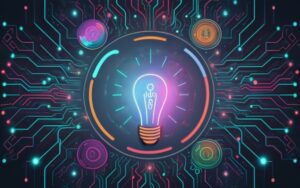The article provides an introduction to NLP and NLP techniques,
- which combines machine learning and linguistic rules to allow computers to understand, interpret, and generate human language;
- it outlines core capabilities like text classification, sentiment analysis, entity extraction, language translation, and topic modeling, along with real-world business use cases across industries;
- the article further details major NLP techniques, from rules-based parsing and semantic analysis approaches to statistical machine learning methods leveraging models like BERT, and the latest multimodal innovations;
- it then explores key challenges around system blindspots, bias, economic impacts, accessibility, and environmental sustainability that require responsible governance;
- finally, the article offers practical guidance for business leaders on navigating adoption, from quantifying success metrics and assessing readiness to defining implementation roadmaps and change management strategies for smoothly integrating NLP capabilities over the long term.

Introduction to Natural Language Processing
Natural language processing (NLP) is a branch of artificial intelligence (AI) that enables computers to understand, interpret, and manipulate human language. Also known as computational linguistics, NLP combines advanced machine learning algorithms with linguistic rules to process written and spoken languages.
The goal of NLP is to achieve human-level language understanding, allowing software to “read” enormous volumes of documents, analyze sentiment and topics, generate summaries, translate between languages, and even create original text.
Why Natural Language Processing Matters - Benefits of NLP
NLP is rapidly transforming how organizations extract insights, improve efficiency, and enhance customer experiences:
Customer service – Chatbots and voice assistants use speech recognition, semantic analysis, and natural language generation to handle millions of customer queries.
Search – Web search leverages NLP techniques like keyword extraction and semantic search to better interpret queries.
Content creation – Tools like Grammarly, Quillbot, and Copy.ai rely on NLP to proofread, rewrite, and generate new content.
Analytics – Sentiment analysis of customer feedback, surveys, and social media conversations provides a real-time voice of customer intelligence.
Process automation – NLP streamlines document analysis for legal contracts, claims processing, report generation, and more.
Core Capabilities of NLP
NLP algorithms can perform a wide variety of language-related tasks:
NLP Capability | Description |
Text classification | Assign tags or categories to text based on its content |
Sentiment analysis | Determine the emotional tone (positive, negative, neutral) of textual content |
Entity recognition | Identify and classify key nouns in text into pre-defined categories like people, organizations, locations, etc. |
Topic modeling | Discover abstract topics and themes in a collection of documents |
Language Translation | Translate text from one language to another |
Top Techniques
There are two core approaches used to develop NLP capabilities:
Rules-based: Uses handcrafted linguistic rules and patterns based on extensive knowledge of computational linguistics. These systems have high interpretability but often fail to capture the fluidity and nuances of human languages.
Machine learning: Automatically learns from labeled and unlabeled examples using statistical models and neural networks. This data-driven approach has fueled most advances in NLP but suffers from bias, opacity, and instability risks.
Hybrid systems combining rules and ML are also gaining traction.
Here are some of the most common NLP techniques leveraged today:
Tokenization – Splitting text into sentences and words
Text classification – Categorize and label documents
Stemming – Reduce words to their root form
Sentiment analysis – Detect emotional tone
Keyword extraction – Identify important terms
Semantic search – Understand the meaning and intent behind search queries
Information extraction – Structured data from unstructured text
Language detection – Identify the origin language of the text
Leading NLP Solutions
There has been rapid innovation in NLP tools and cloud platforms over the last decade:
BERT – Breakthrough NLP model from GoogleAI focusing on language representation
GPT-3 – Advanced language generation model from OpenAI
Amazon Comprehend – AWS service for NLP and natural language understanding
Microsoft LUIS – Azure cognitive service to build language understanding into apps
The Future of NLP
With exponential progress in techniques like deep learning and reinforcement learning, NLP promises to drastically reshape how humans and computers interact using language. Its future applications remain boundless – from real-time speech transcription and seamless mixed-reality interfaces to fully automating customer support and legal functions.
However, there are also growing concerns around bias, accountability, and environmental sustainability that the NLP community must address responsibly. Overall though, NLP’s emergence foretells an exciting future powered by interfaces that adapt to our preferred modes of communication.
Major NLP Techniques and Models
Natural language processing leverages a robust toolkit of techniques and algorithms to ingest, interpret, and generate language. Let’s explore the most impactful approaches propelling NLP capabilities.
Rule-Based vs. Machine Learning Models
NLP systems can be broadly classified into two categories based on their underlying methodology:
Rules-based models: Rely on manually crafted rules and linguistic knowledge.
Excel at handling narrow, domain-specific vocabularies with high precision
Less adaptable to new data outside predefined rule boundaries
Machine learning models: Statistically learn to perform language tasks by analyzing large volumes of text data
Highly flexible, scalable, and can accurately adapt to new linguistic contexts
However, prone to perpetuate biases latent in training data
In practice, hybrid approaches combining rules and ML offer the best of both worlds and are rapidly gaining popularity.
But first, let’s build intuition by examining these seminal NLP techniques:

Powerful Rules-Based Methods
Rules-based NLP techniques apply structured knowledge and logic flows to decipher language:
Technique | Description | Typical Applications |
Parsing | Analyze the grammatical structure of sentences | Machine translation, text summarization |
Part-of-speech tagging | Label words by their syntactic function | Intent detection, sentiment analysis |
Semantic analysis | Assign meaning based on definitions, ontology | Query understanding, contextual chatbots |
- Parsing involves applying grammar templates and vocabulary to systematically break down sentence constructs and relate words accordingly. This allows proper interpretation of complex linguistics like irony that are often misclassified by statistical models.
Part-of-speech tagging carefully uses lexical rules and dictionaries to classify words as nouns, verbs, adjectives, etc. This structured output provides clarity for downstream processes.
Semantic analysis relies on hierarchical ontologies and semantic networks to encode real-world knowledge and eliminate ambiguity. For instance, determining appropriate synonyms based on a term’s meaning.
Statistical and Neural Machine Learning Methods
In contrast, machine learning NLP techniques automatically learn to transform, classify, or simulate language from large datasets:
Technique | Description | Leading Models |
Text generation | Generate coherent language | GPT-3, Jurassic-1 |
Sentence embedding | Encode phrases into vector representations | BERT, LaMDA |
Sentiment analysis | Detect emotional tone | VADER, TextBlob |
Text generation models like OpenAI’s celebrated GPT-3 employ multi-layer transformer neural networks trained on enormous unlabeled text corpora to learn contextual relationships within the language and mimic its fluidity with striking fluency. However, their potential for propagating harmful biases due to ingesting entire Internet scrapes remains hotly debated.
Sentence embedding techniques like Google’s BERT representation model set performance records across various language tasks by innovating bidirectional conditioning to capture semantic meaning within phrases for downstream predictive modeling deeply. However, their intense computational requirements yielding an unprecedented 175 billion parameter models have sparked sustainability implications.
Mature sentiment analysis classifiers like VADER leverage logistic regression on top of heuristically defined linguistic rule sets to categorize the effects of diverse text from tweets to lengthy articles to speeches. They now power a plethora of critical applications – from monitoring population mental health to political polling to guiding business decisions.
Specialized Domain Models
In addition, tailored NLP models targeting scientific, medical, legal, and financial domains continue gaining traction:
BioNLP: Information extraction techniques across genetics literature, biochemistry publications, and clinical notes show immense promise to accelerate biomedical discovery.
LegalNLP: Clustering precedent cases and deeply understanding legal semantics aids judges and lawyers by serving up contextual recommendations.
FinNLP: Fine-tuning sentiment classifiers on earnings reports and economic papers allows quant funds to derive an edge over market moves.
Their careful tuning towards respective vocabulary quirks and structures demonstrably improves subject matter accuracy. However, over-specialization for niche terminology can risk losing generalizability. The remedies are transfer learning techniques like model fine-tuning that adapt pre-trained foundations like BERT to more narrowly constrained domains.
Multimodal Models
Finally, an exciting frontier involves models capable of jointly processing inputs from multiple modes and data types – not just text alone:
Images
Audio
Video
Sensor streams
Metadata
Multimodal NLP promises to enable remarkably sophisticated applications including:
Automated video subtitling by fusing speech, visual, and script cues
Contextualized recommendations by incorporating user activity, identity, and intent data
Assistive technologies for the speech and vision impaired via audio-text-video synthesis
Radically enhanced enterprise search spanning documents, media, conversations, and quantitative analytics
But seamlessly orchestrating such vast heterogeneous, unstructured data at scale introduces daunting research obstacles around optimal modalities fusion techniques and architectures. apropos blending mechanisms remain a largely undiscovered territory.
In summary, major NLP techniques span an expansive spectrum – from purely declarative rules to statistical machine learning to multimodal neural representation learning. Their creative composability continues unlocking the immense latent potential within our reach. The limits appear boundless.
Core NLP Capabilities and Use Cases
NLP algorithms empower software applications to perform a diverse range of language-centric functions that deliver tremendous value across industries.
Let’s explore some of the most popular capabilities and practical use cases within enterprises today.

Text Classification
Text classification is the automated assignment of categories or tags to text based on its content. It unleashes organization-wide intelligence by structuring mammoth volumes of unstructured data.
Models | Accuracy | Training Data |
Logistic Regression | 85% | Thousands of labeled samples |
Support Vector Machines | 90% | Millions of samples |
BERT Classifier | 95% | Billions of parameters |
Effective for sentiment analysis, topic tagging, spam detection, etc.
Flags priority emails, directs queries, triages cases
Macro trends across customer feedback
Sentiment Analysis
Sentiment analysis extracts affective tone from textual data – whether positive, negative, or neutral on a certain topic.
It provides indispensable market and competitive intelligence:
Brand health tracking from social media
Product satisfaction metrics from reviews
Thought leadership inference from industry forums
Shareholder activism prediction from financial disclosures
Public Sentiment Models | Private Customization |
VADER (Valence Aware Dictionary) | Fine-tune polarity lexicons |
TextBlob | Incorporate domain ontology |
Google Cloud NL API | Leverage unlabeled client data |
It also enables critical applications in societal sectors like public policy and mental healthcare.
Entity Recognition
Entity recognition classifies key nouns in text into pre-defined categories such as persons, organizations, locations, medical codes, etc.
It expedites search, compliance, and business analytics:
Category | Use Cases |
Names | Know Your Customer (KYC) workflows |
Brands | Competitor tracking |
Addresses | Tax and financial audits |
UPCs | Inventory and logistics |
Accelerates document review
Digitizes handwritten forms
Structures conversational data
Innovations like Bidirectional Encoder Representations from Transformers (BERT) have recently advanced state-of-the-art.
Topic Modeling
Topic modeling is an unsupervised NLP technique that studies word patterns across documents to discover abstract topics. It finds hidden structure and meaning.
It powers next-generation business intelligence dashboards spanning:
Social listening
CRM databases
Financial filings
Marketing reports
Scientific literature
Algorithm | Insights | Limitations |
Latent Dirichlet Allocation (LDA) | Interpretable topics and keyword clusters | Static analysis without word relationships |
BERTopic | Handles multiple themes and relations | Restricted corpus size |
Use cases range from content organization to document search to analyzing client feedback.
Language Translation
Machine translation automates the conversion of text between thousands of human languages – both major and regional.
It expands access and understanding to new frontiers:
Global customer experiences
Multinational research
Export markets penetration
Outsourcing partnerships
Model | Capability |
Google’s Neural MT | Zero-shot translation across 100+ languages |
SYSTRAN | Deployable for enterprise security and control |
ModernMT | Leading model accuracy customized to industry vocabulary |
From manuals to meetings, machine translation unshackles organizations from language barriers.
Customer Insights

NLP delivers an unprecedented competitive advantage – continuous empirical Voice-of-Customer insights from qualitative feedback, queries and conversations.
It overcomes biased surveys and incomplete operational data by harnessing organic language :
Product satisfaction
Service areas for improvement
Comparison shopping patterns
Churn indicators
Personalization opportunities
Data Source | Analysis Technique |
Customer reviews | Aspect-based sentiment modeling |
Support tickets | Intent classification, topic clustering |
Sales call transcripts | Dialogue action tracking |
Social media forums | Trend forecasting of complaints |
The holy grail is generating bespoke analytics tuned to each company’s offerings. This necessitates customized ML models trained on their unique industry lexicon and historical data assets.
Welcome to data-driven listening!
Conversational Interfaces
NLP conversational interfaces manifest as chatbots and digital assistants like Siri that interact using natural dialogue.
They guide users to resolutions and recommendations with minimum clicks:
24/7 automated support
Voice-enabled mobility
Streamlined bookings
Personalized search
Platform | Integrations |
IBM Watson | CRM, ERP, and helpdesk systems |
Microsoft Azure Bot Service | 200+ apps via connectors |
Google Dialogflow | Contact center and productivity tools |
Designing great experiences hinges on:
Intent recognition
Contextual awareness
Clear visual design
Seamless hand-offs
Bots boost engagement, loyalty, and satisfaction when thoughtfully incorporated into omnichannel strategies.
Process Automation
Within enterprises, NLP drives unprecedented productivity gains by ingesting vast documents, extracting answers, and triggering workflows.
It alleviates skilled talent shortages for:
Analyzing legal contracts
Processing insurance claims
Compiling financial reports
Generating utility bills
Documents | Common Techniques |
Lease agreements | Named entity extraction, semantic search |
Medical records | Sentiment modeling, alert classification |
Earnings transcripts | Topic detection, summarization |
Job applications | Keyword flagging, skills taxonomy |
End-to-end process automation unlocks the capacity for higher judgment tasks.
The competitive imperative is a unified platform combining RPA bots, analytics, and NLP. Welcome to the autonomous organization!
Search and Recommendations
NLP advances search and recommendations in four key dimensions:
Understanding unique characteristics of queries and content
Determining optimal retrieval sources
Ranking results by contextual relevance
Generating clarifying responses to enrich the user experience
User Intent | NLP Capabilities |
Disambiguate acronyms | Entity linking, word sense disambiguation |
Broad exploratory research | Query refinement, contextual suggestions |
Locate niche products | Catalog tagging, faceted navigation |
Troubleshoot software issues | FAQ matching, actionable microcopy |
Latent semantic analysis, topic modeling, and embedding techniques enable next-generation semantic search.
Challenges and Future Outlook
While natural language processing drives tremendous innovation across industries, it also introduces complex challenges at the technology frontier.
Let’s examine crucial limitations and an exciting outlook for the road ahead.
System Blindspots
A fundamental issue involves correctly handling scenarios outside an NLP model’s training distribution, where its confidence far exceeds its competence.
Absent holistic scene understanding, language generation risks:
Logical inconsistencies
Factual errors
Harmful instruction generation
For instance, chatbots told to be helpful can provide dangerous medical advice with sometimes deadly consequences.
Addressing such model blindspots requires:
Focused dataset collection
Reinforcement learning from feedback
Reasoning about commonsense constraints
Formal verification techniques
So that reliable safeguards against unsafe responses are instituted.
Bias and Fairness
Machine learning models frequently inherit and amplify societal biases latent in training data. This causes discriminatory model behavior.
For example, resume screening tools that propagate gender stereotypes or facial analysis that disproportionately misclassifies skin tones.
Debiasing NLP models remains an acute challenge necessitating:
Thoughtful data filtering
Counterfactual augmentation
Improved population representation
Techniques like adversarial debiasing
Broadening accessibility
To promote equitable outcomes, inclusiveness must be institutionalized early via frameworks such as the Diversity Charter.

Environmental Implications
Recent NLP breakthroughs rely on massively scaled computational infrastructure with staggering energy consumption.
175 billion parameter foundation models require thousands of GPU years emitting sizable CO2 emissions
Continual fine-tuning and deployment maintain this constant burden
Pursuing ecologically sustainable NLP motivates:
Efficient model designs
Low-emission hardware
Renewable resourcing
Carbon offset programs
Industry-academic collaborations
So progress responsibly balances innovation with environmental consciousness.
Economic Concerns
Many fear advanced generative text models like GPT-3 threaten several industries by automating creative jobs. However, human creativity manifests in multifaceted ways difficult to fully codify.
Therefore, responsible NLP stewardship should:
Sponsor skills retraining programs
Shape policy encouraging responsible AI
Prioritize augmenting human capabilities over pure automation
Institute licensing fees funding public resources
The Democratization Imperative
Finally, as organizations rapidly adopt NLP, access disproportionately accrues to large tech firms, putting smaller players at a disadvantage.
Remedies promoting inclusivity include:
Platform cooperatives
Open standards
Public-private partnerships
Widespread STEM education
So everyone enjoys the dividends from societal advancements.
In total, optimizing NLP’s benefits while equitably mitigating downsides constitutes an ethical imperative for material progress.
The Outlook Ahead
Looking forward, applications will continue proliferating across domains as techniques mature.
Growth drivers include:
Expanding modalities – video, sensor data fusion
Increasing specialization – scientific, medical, etc.
Enhanced cognitive abilities – reasoning, common sense
Tighter anthropic alignment – cooperative, truthful
Equally, addressing outlined ethical challenges can nurture untrammeled, equitable growth.
Sustaining an inspiring balance between humanity’s interests and innovations remains essential for NLP to elevate living standards for all.
Getting Started with NLP
With exponential NLP advances revolutionizing applications across sectors, harnessing its possibilities early affords organizations a potent competitive edge.
Let’s demystify the initial steps to embark on your NLP journey.
Landscape Evaluation
Myriad enterprise software vendors now offer NLP capabilities. Comparing solutions involves weighing:
Supported languages – English, Spanish, Chinese, etc.
Core competencies – sentiment analytics, search, etc.
Vertical expertise – healthcare, legal, finance
Compatible data formats – text, PDFs, images
Cloud vs. on-premise – control tradeoffs
Managed services – implementation support
Cloud services like AWS Comprehend lower initial barriers but require vigilance around privacy and dependency risks.
Understanding crucial architectural considerations facilitates prudent platform decisions.
Defining Priority Use Cases
The glut of possibilities with NLP can overwhelm initial planning. An actionable strategy involves:
Taking inventory of initiatives facing language-related bottlenecks
Estimating resulting time and revenue savings from enhanced automation
Prioritizing 1-2 high-impact use cases demonstrating quick wins
Common tackling points include analyzing customer feedback, extracting insurance claim details, or developing conversational chatbots.
Quantifying returns and focusing on tangible improvements seeds organization-wide buy-in.
Assembling Skill Sets
Depending on selected use cases, accumulating requisite multidisciplinary skills is imperative:
Domain expertise – medical, marketing, etc.
Data engineering – architects, business analysts
Machine learning – model development and evaluation
Software engineering – production deployment
UX design – interfaces for end users
Cultivating accurate mental models about capabilities and limitations prevents overpromising. Favoring gradual mastery enables compounding capabilities.
Curating Linguistic Data
Machine learning NLP success relies on data volume and quality. Where suitable datasets lack, investments should focus on:
Expanding textual archives like client correspondence
Digitizing paper documents and audio via scanning and transcription
Clean label generation for sentiment analysis
Deidentifying personal information
Curating domain-specific datasets fuels superior custom models. Leveraging pretraining on large general corpora mitigates overfitting.
Options to generate synthetic training data help, but human evaluation remains essential for now.
Governance Guardrails
Finally, responsible NLP necessitates cross-functional involvement in sustained governance addressing:
Testing rigor – stress cases, user studies, A/B trials
Monitoring fairness – bias testing, impact assessments
Securing privacy – encryption, access controls
Enabling transparency – documenting decisions for recourse
Promoting accessibility – interfaces supporting disabilities
Governance manifests in both organizational processes and ML model properties to uphold public trust.
In total, a thoughtful initiation averting common pitfalls manifests in NLP unlocking immense latent value. The possibilities seem endless!
Ethical Considerations for Responsible NLP
As enterprises rush to capitalize on NLP’s promise, thoughtful governance balancing benefits and risks becomes imperative.
Let’s explore crucial issues and emerging best practices for responsible NLP stewardship.

Trust and Transparency
Users relying on NLP systems make impactful decisions without visibility into model logic or confidence bounds. This asymmetry erodes trust when inevitably encountering limitations.
Rebuilding user faith involves multifaceted transparency:
Articulating design choices and tradeoffs
Explaining model behaviors for specific cases
Quantifying reliability metrics and risk factors
Soliciting continual feedback
Interface cues clarifying uncertainty and boundaries foster calibrated expectations and joint learning.
Fairness and Bias
ML models frequently inherit and amplify societal biases latent in training data causing discriminatory behaviors like:
Résumé screening exhibiting gender stereotypes
Facial analysis algorithms misclassifying skin tones
Toxic language models antagonizing minority groups
Holistic debiasing entails:
Thoughtful dataset filtering and augmentation
Techniques like adversarial debiasing during training
Ongoing bias benchmarking across user segments
Inclusive design processes consulting affected groups
So benefits accrue equitably while preventing exclusion or polarization.
Safety and Containment
With increasing autonomy, NLP systems carrying capacity for harm require stringent safeguards such as:
Restricting deployment contexts to avoid abuse
Formal verification of safety properties
Reinforcement learning from human oversight
Editable memory and stopping criteria
Responsible containment limits dangerous, illegal, or injurious generations.
Economic Impact
Rapid advances in generative language raise anxieties about mass creative job displacement while disproportionately benefiting tech monopolies.
Ensuring just transitions involves:
Policy shaping technology for equitable growth
Public-private partnerships for worker retraining
Licensing fees funding public resources
Antitrust regulation of markets
So gains translate into broadly shared prosperity.
Sustainability
Recent NLP breakthroughs rely on magnitudes more computing infrastructure with staggering energy consumption challenges.
Pursuing sustainable progress necessitates:
Optimized model designs
Low-emission hardware
Renewable energy sourcing
Carbon offset programs
Balancing innovation pace with environmental consciousness remains imperative.
Accessibility
Maximizing NLP advantages for differently abled groups means holistically considering:
Native app navigation accessibility
Alt text descriptions for visual elements
Captioning and transcripts for audio
Reader modes aiding cognition
Interface customization options
Fostering inclusiveness requires:
Universal design principles
Disability community involvement
Assistive capability investment
So all can flourish amidst common progress.
In total, conscientious NLP stewardship centering ethics and inclusion offers a blueprint for technology elevating shared dignity.
NLP for Sentiment Analysis and Voice of Customer Intelligence
Understanding customer perceptions, preferences, and pain points is indispensable for organizations to deliver delightful experiences and outcompete rivals.
Natural language processing unlocks this panoramic feedback lens to guide decisions.
Let’s explore crucial techniques and applications.
Deriving Qualitative Insights at Scale
Traditional operational data offer incomplete visibility by lacking rich contextual details from customer interactions including:
Detailing satisfying or frustrating experiences
Articulating desired enhancements
Benchmarking against alternatives
Explaining purchase drivers or churn triggers
NLP overcomes scalability hurdles in analyzing unstructured feedback like:
Product reviews
Social media posts
Call transcriptions
Email and chat logs
Automated text analytics drive previously impossible insights velocity and customization.
Sentiment Analysis
Sentiment modeling is the NLP technique applying machine learning classifiers to categorize opinions in text as:
Positive
Negative
Neutral
It quantifies subjective customer attitudes towards:
Brands
Products
Competitors
Policies
Business use cases span:
Tracking brand health KPIs
Benchmarking product satisfaction
Monitoring market reception to campaigns
Predicting customer churn risk
Tools and Models
Platform | Description |
AWS Comprehend | Cloud API for custom and multi-language sentiment classification at scale |
MeaningCloud | Specialized sentiment analysis for social media and news content |
VADER | Widely used standalone Python model using valence scoring |
Aspect-Based Modeling
Analyzing sentiment towards fine-grained attributes and experiences provides actionable voice-of-customer intelligence.
For example, diagnosing which checkout flow steps most frequently prompt abandonment requires correlating:
User review text
Overall star rating
Aspect-level feedback
This granularity fuels precise understanding and resource allocation.
Topic Modeling and Clustering
While sentiment modeling quantifies effect, understanding latent themes driving praise or complaints requires Topic Modeling to discover:
Frequent suggestion categories
Emergent complaints and desired features
Reasons behind churn
It structures organic conversations for tracking and drilling down.
Common unsupervised learning algorithms include:
Non-negative Matrix Factorization
Latent Dirichlet Allocation
K-means clustering
Efficient implementations are available in libraries like Gensim and enterprise analytics platforms.
Competitive Benchmarking
Analyzing competitor reviews offers rare intelligence to calibrate relative strengths and weaknesses.
It requires adapting taxonomy tagging and topic clustering to discover:
Feature gaps to prioritize
Brand positioning opportunities
Upsell potentials from feature importance
Deriving such empirical competitive insights remains a nascent but invaluable application.
NLP for customer data analytics offers indispensable intelligence distribution for aligning organizations with their evolving stakeholders. Competency development promises significant first-mover advantages.
Evaluating NLP Solutions
Selecting capable natural language processing software from an expanding landscape of vendors poses daunting challenges for enterprises.
Let’s demystify prudent evaluation criteria spanning technology, teams, and total ownership costs.

Comparing Core Competencies
Diverse solutions target distinct applications like:
Sentiment analytics
Intelligent search
Chatbots
Key vendor differentiators include:
Supported languages breadth
Cloud API or on-premise installation
Accuracy across standard benchmarks
Customization flexibility
Ease of getting started
These drive platform recommendations tailored to business use cases.
Assessing Architecture Tradeoffs
Cloud offerings simplify hands-off provisioning but demand scrutiny around:
Vendor dependency risks
Customization constraints
Data privacy and sovereignty
Transparent communication bolsters trust in ethical AI practices that respect human values.
For ultimate control, on-premise solutions necessitate:
Dedicated ML engineering teams
Kubernetes proficiency
Diligent model monitoring
Unless core competency, managed services help navigate technical complexities.
Scaling Internal Capabilities
Long-term success relies on cultivating multi-disciplinary talent encompassing:
Domain expertise to specify requirements
Data engineering to handle pipelines
Machine learning ops to manage ongoing development
Software engineers to deliver applications
UX design for usability and transparency
Favoring gradual mastery compounds organizational capabilities.
While lacking capabilities, outsourcing discrete modules preserves focus but continuity risks engender vendor lock-in without know-how transfer.
Budgeting Total Cost of Ownership
TCO tradeoffs over 3-5 years involve balancing:
Licensing and machine costs
Engineering time
Vendor professional services
Cloud and infrastructure fees
On-premise solutions demand significant upfront and ongoing investments. Cloud lowers these fixed costs but incurs continual operating expenses, necessitating workload profiling.
Cost-benefit analysis offers the ultimate arbiter for determining suitable NLP adoption strategies personalized to business environments.
In total, navigating vendor claims through holistic diligence amended by a long-term strategic vision catalyzes prudent decisions unlocking immense latent value.
Business Leader's Guide to Adopting NLP
With natural language processing rapidly becoming integral across industries, late movers risk significant disadvantages.
For smooth adoption, business leaders should spearhead structured initiatives spanning build-the-case, implementation, and change management.
Let’s demystify key considerations.
Evangelizing & Enrolling
First, lighthouse projects with engaged executives and teams build conviction.
Success elements involve:
Education – Literacy around capabilities to articulate possibilities
Empathy – Deep understanding of various group incentives
Enthusiasm – Motivating pilot participation and reinforcing beliefs
Equally, including doubting voices to address concerns prevents sabotage.
Quantifying quick wins also fosters buy-in by demonstrating value.
Operational Readiness Review
Next, candidly appraising institutional readiness helps calibrate strategies:
Data availability – Volume, quality, and accessibility
Legacy processes – Digitization gaps limiting innovation
Talent landscape – Model development and productization skills
IT roadmaps – Foundational modernization dependencies
Gaps can be addressed through training, vendors, or acquisitions.
Defining Success
Since adopting NLP involves sizable investments, astute leaders insist on clarity for:
Key business objectives – cost savings, revenue gains, risk reduction
Success metrics and targets – worker productivity, customer satisfaction
Governance processes – testing, monitoring, accessibility standards
Milestones review – to guide iteration aligned to outcomes
These constitute North Star’s guiding priorities amidst complexity.
Implementation Roadmap
With foundations cemented, balanced delivery pacing matters:
Quick wins realization – Demonstrate capabilities early, even if limited
Capabilities compounding – Let expertise and infrastructure accumulate
Managing debt – Refactor and simplify to avoid unmaintainable systems
Strategic budgeting – Multi-year resource allocation tuned to growth
Sustaining velocity relies on architecting for agility from the outset.
Change Management
Finally, adoption necessitates mindset shifts recognizing language technologies as strategic assets rather than cost centers.
Tune messaging across groups to emphasize:
New efficiencies – Liberating repetitive work
More meaningful work – Quality interactions
Career growth – Higher-value skills development
Continual engagement curtails anxiety stemming from misconceptions.
In total, patient leadership navigating complex transitions can transform language-driven competitiveness into enduring reality.
Demystifying Natural Language Processing: Frequently Asked Questions
What are some key capabilities of natural language processing (NLP)?
What are the main techniques used to develop NLP algorithms?
What are some common business applications of NLP?
What risks exist around the use of NLP that require governance?
What steps should business leaders take to adopt NLP smoothly?
What does the future outlook seem like for NLP?
Any Other Questions To Ask Our NLP Experts?
That wraps up the most popular questions we get but fire away any others!
Now then artificially intelligent partners – let’s cooperatively get creating! The future awaits no one…🤝
Contact us to discuss your next development project!


